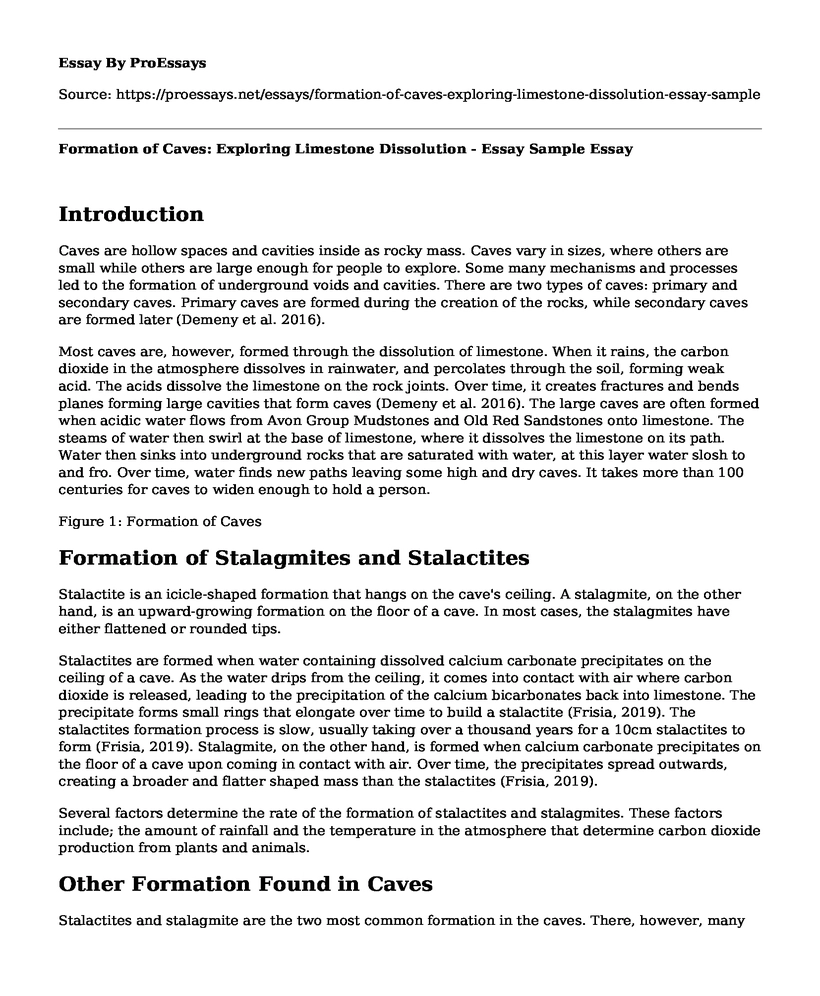Introduction
Caves are hollow spaces and cavities inside as rocky mass. Caves vary in sizes, where others are small while others are large enough for people to explore. Some many mechanisms and processes led to the formation of underground voids and cavities. There are two types of caves: primary and secondary caves. Primary caves are formed during the creation of the rocks, while secondary caves are formed later (Demeny et al. 2016).
Most caves are, however, formed through the dissolution of limestone. When it rains, the carbon dioxide in the atmosphere dissolves in rainwater, and percolates through the soil, forming weak acid. The acids dissolve the limestone on the rock joints. Over time, it creates fractures and bends planes forming large cavities that form caves (Demeny et al. 2016). The large caves are often formed when acidic water flows from Avon Group Mudstones and Old Red Sandstones onto limestone. The steams of water then swirl at the base of limestone, where it dissolves the limestone on its path. Water then sinks into underground rocks that are saturated with water, at this layer water slosh to and fro. Over time, water finds new paths leaving some high and dry caves. It takes more than 100 centuries for caves to widen enough to hold a person.
Figure 1: Formation of Caves
Formation of Stalagmites and Stalactites
Stalactite is an icicle-shaped formation that hangs on the cave's ceiling. A stalagmite, on the other hand, is an upward-growing formation on the floor of a cave. In most cases, the stalagmites have either flattened or rounded tips.
Stalactites are formed when water containing dissolved calcium carbonate precipitates on the ceiling of a cave. As the water drips from the ceiling, it comes into contact with air where carbon dioxide is released, leading to the precipitation of the calcium bicarbonates back into limestone. The precipitate forms small rings that elongate over time to build a stalactite (Frisia, 2019). The stalactites formation process is slow, usually taking over a thousand years for a 10cm stalactites to form (Frisia, 2019). Stalagmite, on the other hand, is formed when calcium carbonate precipitates on the floor of a cave upon coming in contact with air. Over time, the precipitates spread outwards, creating a broader and flatter shaped mass than the stalactites (Frisia, 2019).
Several factors determine the rate of the formation of stalactites and stalagmites. These factors include; the amount of rainfall and the temperature in the atmosphere that determine carbon dioxide production from plants and animals.
Other Formation Found in Caves
Stalactites and stalagmite are the two most common formation in the caves. There, however, many other creations apart from the two. All mineral formations found in the caves are called speleothems (Spotl et al. 2016). They are typically formed in dolomite or limestone solutional caves. Most speleothems are calcareous made of calcium carbonate in the form of aragonite or calcite, or even gypsum made from calcium sulfate (Spotl et al. 2016). Several types of speleothems are found in caves. These types include dripstones, flowstone, and cave crystals. Stalactites and stalagmite are categorized under dripstones. Flowstones, on the other hand, are sheet-like formation found on the walls and floors of caves (Spotl et al. 2016). Formations under this category include draperies, gours, and stone waterfall formations (Spotl et al., 2016). Cave crystals speleothems include frostwork, dogtooth spar, moonmilk, anthodites, and cryogenic calcite. There are, however, other formations that are created as a result of the removal of bedrocks rather than precipitation of secondary deposits (Spotl et al., 2016). These formations include pillar, boneyard, scallops, and boxwork. All these formations are called speleogens. Other formations include cave pearls, cave popcorns, snottites, hells bells, and calcite rafts (Spotl et al., 2016).
Figure 2: Formations Inside Caves
A Stalactite. B Soda straws. C Stalagmites. D Coned stalagmite. E Stalagnate or column. F Drapery. G Drapery. H Helictites. I Moonmilk. J Sinter pool, rimstone. K Calcite crystals. L Sinter terrace. M Karst. N Body of water. O Shield. P Cave clouds. Q Cave pearls. R Tower cones. S Shelfstones. T Baldacchino canopy. U Bottlebrush stalactite. V Conulite. W Flowstone. X Trays. Y Calcite rafts. Z Cave popcorn or coralloids. AA Frostworks. AB Flowstone. AC Splattermite. AD Speleoseismites. AE Boxworks. AF Oriented stalactite. AG collapsed rubble.
References
Demeny, A., Nemeth, P., Czuppon, G., Leel-Ossy, S., Szabo, M., & Stieber, J. (2016). Formation of amorphous calcium carbonate in caves and its implications for speleothemresearch. Scientific reports, 6, 39602. https://www.nature.com/articles/srep39602
Frisia, S. (2019). Stalactites and stalagmites. In Encyclopedia of Caves (pp. 1041-1048). Academic Press. https://www.sciencedirect.com/science/article/pii/B9780128141243001205
Spotl, C., Fohlmeister, J., Cheng, H., & Boch, R. (2016). Modern aragonite formation at near-freezingg conditions in an alpine cave, Carnic Alps, Austria. Chemical Geology, 435, 60-70. https://www.sciencedirect.com/science/article/pii/S0009254116301991
Cite this page
Formation of Caves: Exploring Limestone Dissolution - Essay Sample. (2023, Apr 28). Retrieved from https://proessays.net/essays/formation-of-caves-exploring-limestone-dissolution-essay-sample
If you are the original author of this essay and no longer wish to have it published on the ProEssays website, please click below to request its removal:
- Advantages and Disadvantages of a Flipped Math Classroom
- Personal Statement Example: Designing and Developing a Three Phase Electrical System
- Napkin Ring Problem Analysis
- Assignment Example on Energy Strength of the Bond
- Essay on Math & Religion: Exploring Their Connections in Life
- Street Drugs: Stimulants, Depressants, Opioids, Hallucinogens - Essay Example
- Essay Example Air Quality Studies: Gaussian Plume & Box Models







